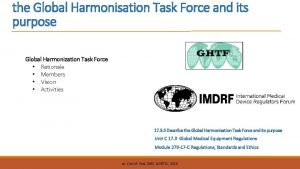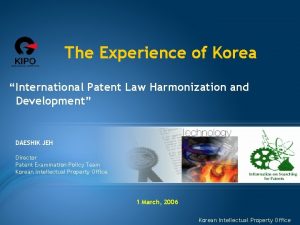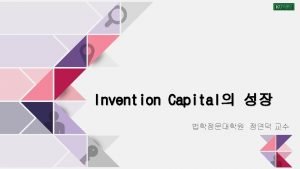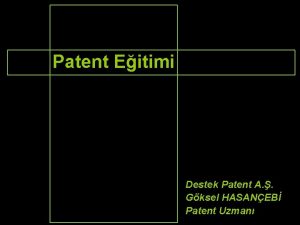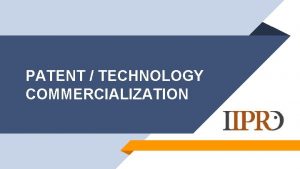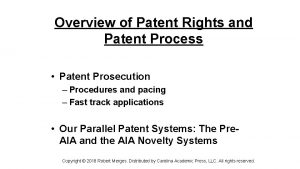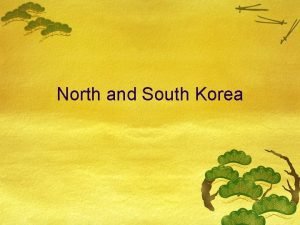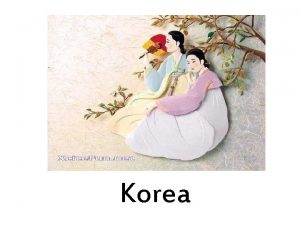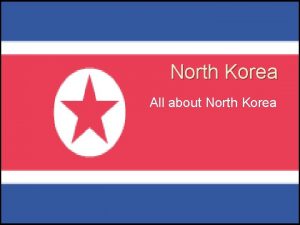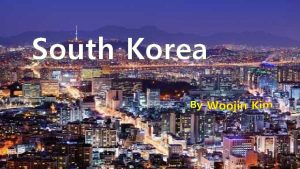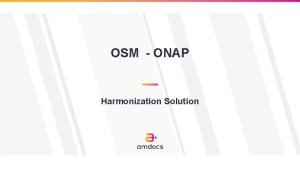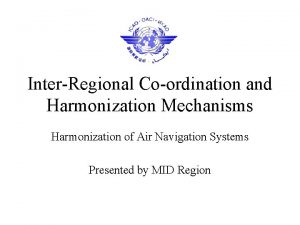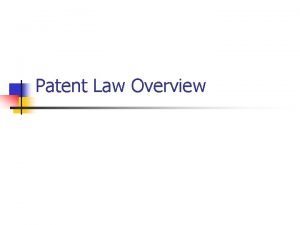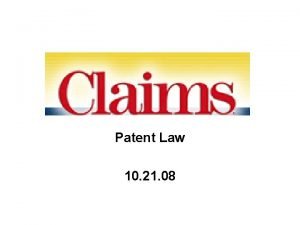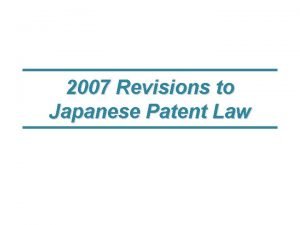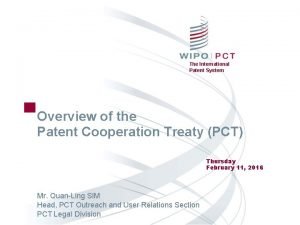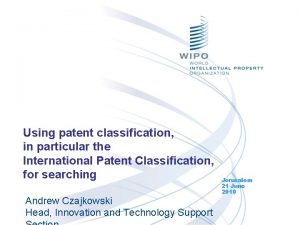The Experience of Korea International Patent Law Harmonization



























- Slides: 27

The Experience of Korea “International Patent Law Harmonization and Development” DAESHIK JEH Director Patent Examination Policy Team Korean Intellectual Property Office 1 March, 2006 Korean Intellectual Property Office

Table of Contents 2 Ⅰ. Economic Growth Ⅱ. KIPO‘s Efforts for Harmonization Ⅲ. Patent Statistics Ⅳ. Effect of IP on Economic Growth Ⅴ. Vision of KIPO Open Forum 9

Ⅰ. Economic Growth (1) 3 Seoul in 1961 Open Forum 9 Seoul in 2005

Ⅰ. Economic Growth (2) 4 � 14. 5% annual growth rate of GDP between 1961 ($2. 3 billion) and 2005 ($768 billion) Unit : B (billion), M (million) Year Category GDP Open Forum 9 1961 (a) 2005 (b) b/a (Times) $ 2. 3 B $ 768 B 334 GDP P/C $ 87 $ 16, 000 184 EXPORT $ 55 M $ 284. 4 B 5, 170 IMPORT $ 390 M $ 261. 2 B 670

Ⅰ. Economic Growth (3) 5 �Amazing growth of economy (1986 -1996) - 18. 5% annual growth rate of GDP Per Capita from 2, 643 (’ 86) to 12, 197(’ 96) �Overcame the financial crisis (1997~2005) - Developing a new growth engine in the fields of IT, BT and NT Open Forum 9

Ⅰ. Economic Growth (4) 6 Before Industrialization (1945 -1961) Ruined and divided country owing to the threeyear Korean War (1950 -1953) No national consensus for developing industries No money for building factories One of the poorest countries in the world Open Forum 9

Ⅰ. Economic Growth (5) 7 Early Industrialization (1962 -1981) Government drove the industrial policy (The Economic Development Plan) Companies depended heavily on imported technologies Focused on the light industries, such as fabric, plywood and footwear industries, etc. Factories were built by foreign loans Open Forum 9

Ⅰ. Economic Growth (6) 8 Growing Industrialization (1982 -1996) Private sectors led the development and government supported companies Companies turned to the heavy and chemical industries, such as steel, shipbuilding and automobile industries Grew as a developing country Open Forum 9

Ⅰ. Economic Growth (7) 9 Maturing industrialization (1996 -2005) Overcame the financial crisis in three years by financial support from the IMF Many failing companies fell under control of foreign capital during liquidation Turned to technology-intensive industries such as mobile phone, semiconductor and display industries Tried to shift from a developing country to an advanced country Open Forum 9

10 Ⅱ. KIPO’s Efforts for Harmonization (1) Progress of the IP System (1) Introducing the modern IP system (1961) -Patent, Utility Model, Design, and Trademark -Introduced claiming priority of Paris Convention (1973) Enhancing the IPR system in accordance with the international standard (1980 s) - Joined the WIPO (1979) - Joined the Paris Convention (1980) - Joined the PCT (1984) - Expanded the scope of patentable subject matter (included substance patent (1986) and food patent (1990)) Open Forum 9

11 Ⅱ. KIPO’s Efforts for Harmonization (2) Progress of the IP System(2) Strengthening the IPR protection (1990 s) - Joined the WTO/TRIPs (1995) - Extend the term of protection to 20 years counted from the filing date (1995) - Extended the scope of patent licensing to “subscription to an assignment or leasing” of a patent right (1995) - Established the Patent Court (1998) - Regard technologies published on the Internet as the prior art (2001) Open Forum 9

12 Ⅱ. KIPO’s Efforts for Harmonization (3) Amendment for Harmonization(1) Reflecting the Paris convention and PCT - Introduced claiming priority of Paris Convention (1973) - Extended the time limit for submission of a translation of a PCT application to 31 months (2005) - Introducing a system for restoring patent protection within a certain period of time if protection has lapsed by reason of failure to pay annual fees (2005) Open Forum 9

13 Ⅱ. KIPO’s Efforts for Harmonization (3) Amendment for Harmonization(2) Reflecting the SPLT draft - To include any kind of information available to the public, in Korea or other countries, in the prior art (2005) - Not to restrict the type of publication of a prior art item insofar as the prior art item does not affect the patentability of a claimed invention (2005) Open Forum 9

14 Ⅱ. KIPO’s Efforts for Harmonization (4) Amendment for Harmonization(3) Reflecting the WTO/TRIPs - Included substance patents as subject matter (1986) - Extend the term of protection to 20 years counted from the filing date (1995) - To grant a non-exclusive license to export medical products to countries that try to import the medicinal products to treat diseases threatening their public health (2005) Open Forum 9

Ⅲ. Patent Statistics (1) 15 �Increase in patent & utility model applications - 193, 364 patent & utility model applications were filed with KIPO in 2005. - The number of patent applications in 2005 (121, 467) increased 105 times, compared to that in 1970 (1, 846). Open Forum 9

Ⅲ. Patent Statistics (2) 16 �Number of patent registrations in KIPO - The number of annual patent registrations increased 41 times: 1, 808 (1981) → 73, 509 (2005) - The ratio of the annual patent registrations by residents to those by foreigners increased from 12. 8% (1981) to 72. 7% (2005). Open Forum 9

Ⅳ. Effect of IP on Economic Growth (1) 17 �The number of patent/utility model applications has increased along with economic growth since 1970 s. Open Forum 9

Ⅳ. Effect of IP on Economic Growth (2) 18 Case study of Korea Increase in patent applications → Technological development → Increase in GDP Increase in patent applications by 1% → Increase in economic growth rate by 0. 11% The growth rate of patent applications is closely related to the long-term economic growth rate (Source: “Report of Korea Development Institute 2003”) Open Forum 9

Ⅳ. Effect of IP on Economic Growth (3) 19 �Effect of IP on Korean economy - Negative effect: Still paying a large amount of royalties Spent $ 4. 1 billion in 2004 - Positive effect: Increase in the ratio of technology export to technology import: 8. 7% (’ 94) → 34. 2% (’ 04) Open Forum 9

Ⅳ. Effect of IP on Economic Growth (4) 20 Before protect substance patents Produced pharmaceutical products and chemical compounds without licensing substance patents before 1987 Domestic companies were strongly opposed to protection of substance patents. After protect substance patents pharmaceutical and chemical companies made efforts to protect substance patents Investment in R&D increased. Many research institutes were founded. New medicines made from new substances were licensed. Open Forum 9

Ⅳ. Effect of IP on Economic Growth (5) 21 �Effects of substance patents on the pharmaceutical industry after starting to protect substance patents in 1987 Effects Contents The ratio of R&D to sales in the pharmaceutical fields 0. 7% (’ 86) → 5. 75% (’ 99) The Number of research institutes in the pharmaceutical fields 31 (’ 85) → 216 (’ 04) The number of new medicines 11 items licensed 92 items under development Technology export exceeded technology import at 2000 Export ($23. 5 M) Import ($18. 7 M) Open Forum 9

Ⅳ. Effect of IP on Economic Growth (6) 22 �The number of applications by residents increased 26 times [35 applications (1987) → 906 (2005)] �The ratio of applications by residents increased [ 4. 2% (1987) → 35. 3% (2005)]. Open Forum 9

Ⅴ. Vision of KIPO (1) 23 Main Targets of KIPO 1. To lead technology innovation through rapid, highquality examinations and trial decisions 2. To promote efficient R&D projects by encouraging the active use of patent information nationwide 3. To support nationwide IP development by establishing the IP infrastructure 4. To promote awareness of the importance of IP and to consistently protect IP Open Forum 9

Ⅴ. Vision of KIPO (2) 24 Main Activities of KIPO (1) 1. Reducing the examination period from 17 months in 2005 to 10 months by the end of 2006 - Recruiting new examiners (280 examiners in 2005 and 2006) 2. Reducing the patent trial period from 12 months in 2005 to 6 months by the end of 2006 3. Improving the employee-invention system - Amending the law to promote mutual interests between employers and employees 4. Enforcing the law against illegal activities of manufacturing and selling counterfeit products Open Forum 9

Ⅴ. Vision of KIPO (3) 25 Main Activities of KIPO (2) 1. Promoting use of patent information by public sectors in governmental R&D projects 2. Designated as an ISA/IPEA by PH, VN, ID, IN, Mongolia, Singapore, NZ and the US 3. Executing the joint prior-art search program with Japan, China and Australia 4. Improving the KIPOnet system - Providing year-round filing service Open Forum 9

Ⅴ. Vision of KIPO (4) 26 Conclusion 1. Korea needs to strategically use IP as a tool for sustainable economic development 2. KIPO fully supports technology innovation 3. KIPO consistently protects intellectual property 4. KIPO strongly supports the harmonization of international patent law Open Forum 9

27 Thank you for your attention! DAESHIK JEH kipo 2006@kipo. go. kr Phone: +82 -42 -481 -5389, Fax: +82 -42 -472 -3470 Open Forum 9
 Salary harmonisation
Salary harmonisation Global harmonisation task force
Global harmonisation task force Data dictionary best practices
Data dictionary best practices Korean international school jeju
Korean international school jeju Korea international school jeju
Korea international school jeju Hot topics in patent law
Hot topics in patent law Experience expectant vs experience dependent
Experience expectant vs experience dependent Early experience vs later experience
Early experience vs later experience Direct experience and indirect experience
Direct experience and indirect experience Newton's first law and second law and third law
Newton's first law and second law and third law Newton's first law
Newton's first law Boyle's law charles law avogadro's law
Boyle's law charles law avogadro's law How to calculate boyle's law
How to calculate boyle's law International experience resume
International experience resume Hát kết hợp bộ gõ cơ thể
Hát kết hợp bộ gõ cơ thể Slidetodoc
Slidetodoc Bổ thể
Bổ thể Tỉ lệ cơ thể trẻ em
Tỉ lệ cơ thể trẻ em Chó sói
Chó sói Chụp phim tư thế worms-breton
Chụp phim tư thế worms-breton Bài hát chúa yêu trần thế alleluia
Bài hát chúa yêu trần thế alleluia Kể tên các môn thể thao
Kể tên các môn thể thao Thế nào là hệ số cao nhất
Thế nào là hệ số cao nhất Các châu lục và đại dương trên thế giới
Các châu lục và đại dương trên thế giới Công thức tính độ biến thiên đông lượng
Công thức tính độ biến thiên đông lượng Trời xanh đây là của chúng ta thể thơ
Trời xanh đây là của chúng ta thể thơ Mật thư tọa độ 5x5
Mật thư tọa độ 5x5 Làm thế nào để 102-1=99
Làm thế nào để 102-1=99

